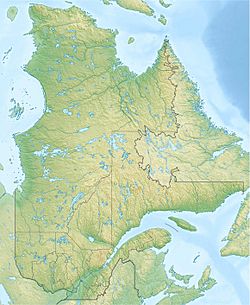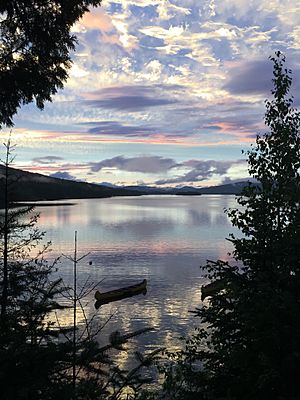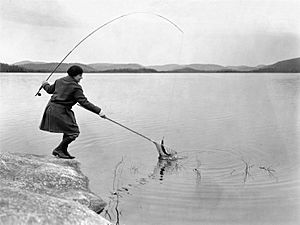Lake Ouareau facts for kids
Quick facts for kids Lake Ouareau |
|
|---|---|
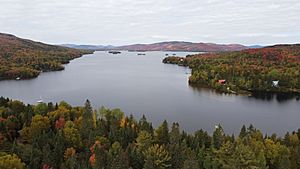
Aerial view of Lac Ouareau from Camp Ouareau in 2020
|
|
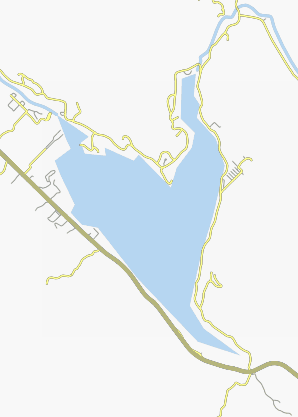 |
|
| Location | Saint-Donat / Notre-Dame-de-la-Merci, Matawinie Regional County Municipality, Quebec |
| Coordinates | 46°17′03″N 74°08′34″W / 46.28417°N 74.14278°W |
| Primary inflows | Ouareau River |
| Primary outflows | Ouareau River |
| Basin countries | Canada |
| Max. length | 13 kilometres (8.1 mi) |
| Max. width | 4 kilometres (2.5 mi) |
| Surface area | 14.9 square kilometres (5.8 sq mi) |
| Average depth | 54 metres (177 ft) |
| Surface elevation | 384 metres (1,260 ft) |
Lake Ouareau is a large and beautiful lake located near the town of Saint-Donat in Quebec, Canada. It's a popular spot for thousands of visitors who love outdoor activities.
The lake is about 100 minutes by car north of downtown Montreal. It sits in the Laurentian Highlands, a scenic mountain range. Did you know that singer Celine Dion owns a summer house on Lake Ouareau?
Many roads help people get around the lake. Route 125 South runs along the southwest side, while the Saint-Guillaume path serves the eastern part. The Ouareau North path covers the northern area, including the Baie de la Dame. These roads make it easy for vacationers to enjoy the area.
Lake Ouareau usually freezes over from mid-December to the end of March. It's generally safe to walk or play on the ice from late December to early March.
Contents
Exploring Lake Ouareau
Lake Ouareau is shaped like a "V". It stretches about 13 kilometers (8 miles) long and 4 kilometers (2.5 miles) wide. The lake covers an area of 14.9 square kilometers (5.75 square miles) and has an average depth of 54 meters (177 feet).
The lake has a few interesting parts. The Baie de la Dame is a large bay on the north shore, reaching 3.6 kilometers (2.2 miles) deep. Leguerrier Bay is another bay located in the southeast. Saint-Loup creek flows into the bottom of this bay.
Lake Ouareau also has two main islands: Cave Island, which is close to the southwest shore, and Rupert Island, found in the western part of the lake.
Animals and Plants in the Lake
Lake Ouareau is a great place for fishing! It's home to many freshwater sport fish. You can find fish like largemouth bass, yellow perch, smallmouth bass, and sometimes even muskellunge.
The lake also has many tiny living things called microorganisms. These tiny creatures thrive in clean, healthy northern lakes. In the summer, the water temperature usually ranges from 55 to 78 degrees Fahrenheit (13 to 26 degrees Celsius).
Fun Youth Camps Around the Lake
Three summer camps have been set up around Lake Ouareau over the years, offering fun experiences for young people.
Camp Ouareau
Camp Ouareau is an all-girls camp located on the shores of Leguerrier Bay. It was started in 1922 by Mabel C. Jamieson and Ferna G. Halliday.
Originally, Camp Ouareau was an English-speaking camp. But in 1976, the camp director decided to welcome French-speaking campers too. Now, each age group has an equal number of English and French speakers. This helps campers learn about different languages and cultures while enjoying activities, meals, and cabin life together.
Student Village of Lake Ouareau
The Student Village of Lake Ouareau was established in 1948. It was a place where young girls could attend holiday study camps. This camp could host up to 130 young people. Later, in 1956, it became the La Cordée Youth Center, which focused on organizing fun activities and training for young leaders.
Camp Mère Clarac
Camp Mère Clarac was created in 1957 by the Sisters of Charity of Sainte-Marie. This summer camp welcomes both boys and girls. It covers a large area of 115 acres and can host up to 210 young people each week.
Forest Fires in History
Lake Ouareau has a history with two big forest fires.
- In May 1941, a forest fire near the lake threatened Camp Ouareau. Luckily, the camp was saved thanks to the hard work of up to 300 forest rangers and volunteers.
- In July 1949, the village of Saint-Donat, close to Lake Ouareau, was in danger from two forest fires. Over 150 volunteer firefighters worked to dig trenches and put out the flames. The Lake Ouareau Student Village had to be evacuated, but no houses were burned.
What's in a Name?
The name "Ouareau" comes from the Algonquin language. It means "far" or "distant." This name has been used for the lake and its river since the late 1700s.
The term "Ouareau" appeared on old maps, like one from 1789 by surveyor William Rankins. It was also mentioned in a book about Lower Canada in 1815. For many years, the lake and river were used to transport logs by floating them downstream.
The name "Lac Ouareau" officially became recognized on December 5, 1968.


